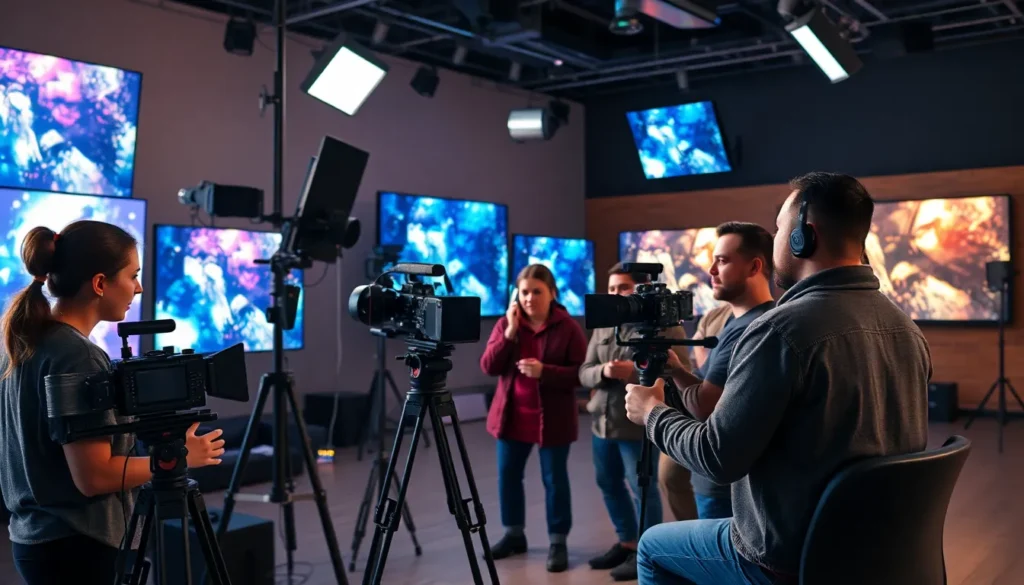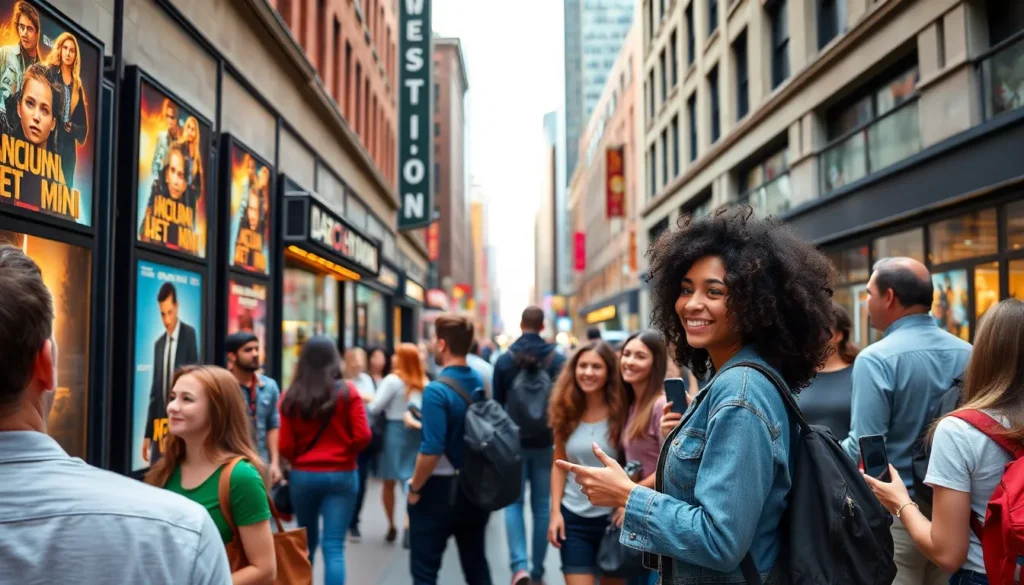The future of movies is shaping up to be a wild ride, and it’s not just about popcorn and oversized sodas anymore. With technology advancing faster than a speeding bullet, filmmakers are diving into realms once reserved for science fiction. Imagine watching a film where you can literally step into the story—no more awkwardly adjusting your seat to avoid that one guy with the loud popcorn crunch.
Future Of Movies
Advancements in technology shape the future of movies. Innovations like virtual reality (VR) and augmented reality (AR) create immersive experiences that engage viewers on a deeper level. Filmmakers embrace interactive storytelling, allowing audiences to influence narrative directions and outcomes.
Data from industry studies indicate that 40% of consumers seek more personalized viewing experiences. This demand prompts studios to explore artificial intelligence (AI) in content creation, using algorithms to analyze audience preferences. Integration of AI enables tailored recommendations, enhancing user engagement.
Streaming services evolve, emphasizing original content to retain subscribers. Reports from market analyses project that by 2026, nearly 70% of all films will premiere on streaming platforms, further altering traditional distribution methods.
Global collaborations expand, bringing diverse voices and perspectives to the forefront. This inclusivity enriches storytelling, allowing for culturally resonant narratives that appeal to broader audiences. Statistics show that films featuring multicultural casts can increase box office revenue by up to 25%.
As technological capabilities grow, filmmakers experiment with 8K resolution and advanced visual effects. Such developments provide audiences with breathtaking visuals that heighten the cinematic experience. The introduction of higher frame rates offers smoother motion, enhancing the realism of action scenes.
In this evolving landscape, sustainability becomes paramount. Many production companies now commit to eco-friendly practices to minimize environmental impact. Efforts include reducing carbon footprints and utilizing renewable resources during film production.
Creativity thrives in the future of movies, driven by technology and collaboration. Enhanced viewer engagement and access to diverse narratives present limitless opportunities for filmmakers. The cinematic journey continues to transform, promising exciting changes ahead.
Technological Advancements

Technological advancements are reshaping the cinematic landscape, bringing innovative experiences to audiences.
Virtual Reality in Cinema
Virtual reality (VR) offers immersive experiences that engage viewers like never before. Filmmakers create environments where audiences interact with stories. Certain productions utilize VR to transport viewers into different worlds, providing a sense of presence. This technology enhances emotional connections, as participants feel part of the narrative. Data indicates that 70% of viewers appreciate more immersive content, driving filmmakers to adopt VR techniques. By incorporating VR, creatives unlock new storytelling possibilities, encouraging unique audience interactions.
Streaming Services and Their Impact
Streaming services are fundamentally changing how films are distributed and consumed. Projections suggest that by 2026, nearly 70% of films will debut on streaming platforms. This shift provides filmmakers access to global audiences without reliance on traditional theaters. Furthermore, data shows that 40% of consumers desire personalized content recommendations, prompting streaming companies to utilize AI for tailored viewing experiences. Content diversity increases as many indie films find homes on these platforms, enriching the cinematic landscape. As a result, streaming not only democratizes film distribution but also expands storytelling opportunities for diverse voices.
Storytelling Evolution
Storytelling in film rapidly evolves, leveraging technology and new formats to captivate audiences. Engaging narratives utilize immersive techniques, allowing viewers to participate in ways previously unimagined.
New Narratives and Formats
Innovators experiment with formats beyond traditional movies. Virtual reality (VR) creates fully immersive experiences, enabling audience interaction with the storyline. Enhanced emotional connections form as viewers navigate through plot arcs. As VR techniques gain popularity, data shows that 70% of viewers prefer this immersive content. Filmmakers also explore interactive storytelling, giving audiences decision-making power that shapes narrative outcomes. This shift fosters dynamic storytelling, encouraging audiences to engage deeply with characters and environments.
Diversity in Film Production
Diverse representation becomes essential in film production. Multicultural casts not only foster authentic storytelling but also enhance box office performance, potentially increasing revenue by 25%. Streaming platforms drive this change, funding numerous indie films that highlight different perspectives and cultures. These companies recognize a growing audience preference for personalized content, leading to richer narratives that reflect society’s variety. Incorporating diverse voices boosts creativity, paving the way for innovative storytelling and breaking the mold of conventional cinema.
Audience Engagement
Audience engagement is transforming with innovative technologies, shifting how viewers interact with films.
Interactive Viewing Experiences
Interactive viewing experiences enhance emotional connections between audiences and narratives. Viewers can now influence story outcomes, creating personalized journeys within the films they watch. Films employing virtual reality techniques offer a sense of presence, allowing immersive interactions. Data shows that 70% of viewers appreciate these advancements, motivating filmmakers to adopt VR and interactive elements. As audiences engage with characters and their decisions, narratives evolve dynamically, leading to richer storytelling. The rise of these experiences encourages filmmakers to experiment continuously with technology, ensuring future films are engaging and memorable.
Social Media Influence
Social media influences audience engagement significantly, providing platforms for discussion and connection. Viewers frequently share their opinions, creating buzz around upcoming releases and fostering community dialogue. Filmmakers monitor social media trends and feedback to understand audience preferences more clearly. Consequently, they tailor marketing strategies, using platforms for targeted promotions. With 40% of consumers desiring personalized recommendations, social media becomes crucial in discovering tailored content. The interplay between social media and film releases cultivates anticipation, making audiences feel part of the cinematic journey.
Industry Challenges
The future of movies faces several significant challenges. The rise of streaming platforms has reshaped audience expectations and viewing habits, creating a divide between theatrical and home viewing experiences.
Theatrical vs. Home Viewing
Filmmakers confront the dilemma of balancing theatrical releases with home viewing preferences. With projections indicating that nearly 70% of films will premiere on streaming services by 2026, traditional cinemas experience declining audiences. Audiences increasingly prefer the convenience of watching films at home. Meanwhile, experiences in theaters typically provide larger-than-life visuals and communal viewing. For filmmakers, understanding this duality is essential for crafting distribution strategies that cater to both preferences and ensure box office success.
Sustainability in Film Production
Sustainability has emerged as a crucial consideration in film production. Production companies increasingly prioritize eco-friendly practices to minimize their environmental footprint. Data shows that adopting green initiatives can improve public perception and attract environmentally-conscious viewers. Films made with sustainable practices often resonate with audiences who value socially responsible production methods. As the demand for diverse storytelling grows, filmmakers can align their production methods with sustainability, contributing to a positive cultural shift within the industry.
Conclusion
The future of movies is poised for remarkable transformation as technology reshapes storytelling and audience engagement. Filmmakers are embracing immersive experiences and interactive narratives that deepen emotional connections.
As streaming services continue to dominate the landscape, they’re offering diverse content that caters to global audiences while promoting sustainability in production practices. This evolution not only enhances the cinematic experience but also encourages a broader representation of voices and stories.
With creativity at the forefront, the film industry is set to thrive in this dynamic environment. The blend of advanced technology and innovative storytelling promises a captivating future for cinema lovers everywhere.



